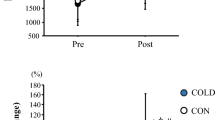Abstract
The purpose of the present study was to examine the discrepancies in rectal temperature (T re) at various depths. Nineteen young males performed two bouts of bicycle exercise and recovery. T re was simultaneously measured at depth of 4, 6, 8, 10, 13, 16, and 19 cm, alongside the measurement of skin temperatures. We found small but statistically significant differences by depth in the absolute T re, the magnitude of rise in T re and the lag of response in T re. During the stabilization stage before exercise, T re at 4 cm-depth was 0.5°C lower than T re at 16 cm-depth (p < 0.05). As the depth measured in the rectum was shallower, the rise in T re during exercise was greater. However the rise in T re at 10, 13, 16 and 19 cm showed no systemic difference. Among seven depths, T re at 16 cm-depth had the most stable feature with the longest latent period (3.1 ± 1.3 min) and the smallest rise (0.8 ± 0.3°C), while T re at 4 cm-depth was the most responsive to the change of exercise and rest with the shortest latent period (1.0 ± 0.6 min) and the greatest rise (1.2 ± 0.5°C). The differences observed in the depths from 4 to 19 cm were offset by exercise to some extent. In summary, T re appeared in different manners according to the seven depths during the repetition of exercise and rest, but T re deeper than 10 cm-depth seemed to have no systematic differences.






Similar content being viewed by others
References
American College of Sports Medicine (1984) Prevention of thermal injuries during distance running. Phys Sport Med 16:139–142
Astrand P, Rodahl KR (1970) Textbook of work physiology. McGraw-Hill KogaKusha Ltd, Tokyo, p 492
Bruck K (1989) Thermal balance and the regulation of body temperature, chap 25. In: Schmidt RF, Thews G (eds) Human physiology. Springer, Berlin, p 628
Burton AC (1963) Ch. 34. the pattern of response to cold in animals and the evolution of homeothermy. In: Herzfeld CM (ed) Temperature: Its measurement and control in science and industry, vol 3; part 3, biology and medicine. Reinhold, New York, pp 363–370
DuBois EF (1936) Basal metabolism in health and disease. Lea & Febiger, Philadelphia, p 424
Edholm OG (1978) Man-hot and cold. Studies in Biology no. 97. Edward Arnold Ltd, London, pp 8–9
Frisancho AR (1993) Human adaptation and accommodation. The University of Michigan Press, Ann Arbor, p 45
Fusco MM (1963) temperature pattern throughout the hypothalamus in the resting dog. In: Herzfeld CM (ed) Temperature: Its measurement and control in science and industry, vol 3; part 3, biology and medicine. Reinhold Publishing Corporation, New York, pp 585–587
Hammel HT (1972) The set-point in temperature regulation: analogy and reality. In: Bligh J, Moore R (eds) Essays on temperature regulation. North-Holland, Amsterdam, pp 121–137
Henschel A, Hanson H (1960) Heat stress in the desert. Am Soc Mech Eng 82:57–60
Henschel A, McPhilimy HS (1963) Field test methods. In: Arid zone research (V. 22) environmental physiology and psychology in arid conditions-reviews of research. UNESCO. p 320
ISO 9886 (1992) Ergonomics—evaluation of thermal strain by physiological measurements. International Organization for Standardization
IUPS Thermal Commission (2001) Glossary of terms for thermal physiology (3rd edition). Jpn J Physiol 51(2):245–280
Karlberg P (1949) The significance of depth of insertion of the thermometer for recording rectal temperatures. Acta Pediatr Scand 38(1):359–366
Leithead CS, Lind AR (1964) Heat stress and heat disorder. FA Davis, Philadelphia, pp 7–55
Mead J, Bonmarito CL (1949) Reliability of rectal temperatures as an index of internal body temperature. J Appl Physiol 2:97–109
Minard D (1970) Body heat content, Chap 25. In: Hardy JD, Gagge AP, Stolwijk JAJ (eds) Physiological and behavioral temperature regulation. Charles C Thomas, Springfield, pp 345–357
Minard D, Copman L (1963) Ch 46 Elevation of body temperature in health. In: Herzfeld CM (ed) Temperature: its measurement and control in science and industry, vol 3; Part 3, biology and medicine. Reinhold, New York, pp 527–543
Nielsen B, Nielsen M (1962) Body temperature during at different environmental temperatures. Acta Physiol Scand 56(2):120–129
Renbourn ET (1972) Materials and clothing in health and disease. H.K. Lewis & Co Ltd, London, pp 189–193
Robinson S (1968) Ch. 5. Physiological adjustments to heat. In: Newburgh LH (ed) Physiology of heat regulation and the science of clothing. Hafner, New York, pp 193–231
Rodahl K (1994) Stress monitoring in the workplace. Lewis Publishers, Boca Raton, p 95
Saltin B, Hermansen L (1966) Esophageal, rectal, and muscle temperature during exercise. J Appl Physiol 21(6):1757–1762
Snellen JW (1972) Set point and exercise. In: Bligh J, Moore R (eds) Essays on temperature regulation. North-Holland, Amsterdam, pp 139–148
Stanier MW, Mount LE, Bligh J (1984) Energy balance and temperature regulation. Cambridge University press, London, pp 63–64
Sund-Levander M, Forsberg C, Wahren LK (2002) Normal oral, rectal, tympanic and axillary body temperature in adult men and women: a systematic literature review. Scand J Caring Sci 16(2):122–128
Zengeya ST, Blumenthal I (1996) Modern electronic and chemical thermometers used in the axilla are inaccurate. Eur J Pediatr 155(12):1005–1008
Acknowledgments
We would like to express our thanks to Sang-Il Lee, Mutsuhiro Fujiwara, Andrew Cookson, and Shizuka Umezaki for their academic advices and mechanical supports. This study was supported by Japan Society for the Promotion of Science (JSPS #P09128). The authors declare that the experiments comply with the current laws of Japan.
Conflict of interest statement
The authors declare that they have no conflict of interest.
Author information
Authors and Affiliations
Corresponding author
Additional information
Communicated by Tatsuo Watanabe.
Rights and permissions
About this article
Cite this article
Lee, JY., Wakabayashi, H., Wijayanto, T. et al. Differences in rectal temperatures measured at depths of 4–19 cm from the anal sphincter during exercise and rest. Eur J Appl Physiol 109, 73–80 (2010). https://doi.org/10.1007/s00421-009-1217-0
Accepted:
Published:
Issue Date:
DOI: https://doi.org/10.1007/s00421-009-1217-0




